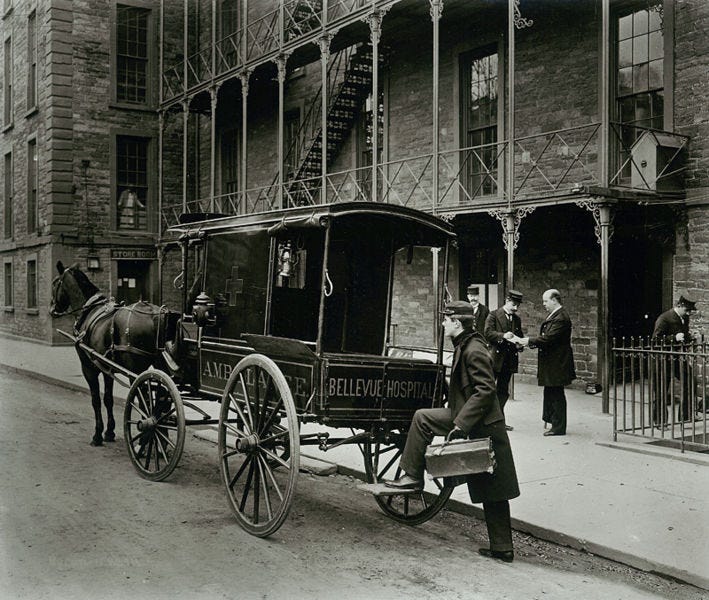In May 1909, nine-year-old Julian Wise watched a boy die. He stood by the river in Roanoke, Virginia, while adults tried to save the lad, whose canoe had overturned. Their panicked efforts were futile. “Right then,” Wise said, “I resolved that I was going to become a life saver.”
Wise grew up, traveled the country with a dance band during the Roaring Twenties, and in 1927 returned home to take a job as clerk for the Norfolk and Western Railroad. A year later, he formed the Roanoke Life Saving and First Aid Crew, a band of volunteers whose mission was to bring emergency care to those in need. He not only created a durable institution—the group still exists today—but started a movement that would have a major impact on emergency health care in America.
Few of us give much thought to what might happen if we suffer a heart attack or a car crash. We assume an ambulance will show up, aid will be rendered, and we will be whisked off to a hospital. But no system to provide such care existed in 1928 or for more than four decades afterwards, especially in rural areas and small towns.
In cities, emergency care might be provided by hospital ambulances staffed by doctors, which began to appear during the horse-drawn era. But in most of the country, victims relied on happenstance. A nearby gas station might have an ambulance to send with the tow truck. A taxi outfit might double as an ambulance company. Victims were often taken to doctors’ offices by passing motorists.
Julian Wise’s idea was to combine rescue and first aid skills in a single squad. At first, his fellow members all worked at the railroad office and emergency calls came there. In 1931 they were summoned to a drowning, reached the scene in eleven minutes, and revived a 16-year-old boy. The national publicity they received helped the idea to grow. Wise traveled around Virginia promoting volunteer squads.
The key concept behind Wise’s band of volunteers was speed. Later research would show that when patients were injured, their bodies could, for a time, compensate for the trauma. If they made it to the emergency room during what was called the “golden hour,” they had a better chance of survival. “Save seconds and you have a better chance of saving a life,” Wise said.
But in rural settings, a lot had to happen in that hour. The alarm had to reach rescuers, they had to collect their equipment and rush to the scene, and the patient had to be loaded into the ambulance and transported some distance to the emergency room. No system to make this happen existed.
Even during the 1960s, the most common providers of emergency care were funeral homes. Some maintained dedicated ambulances; some used hearses that could accommodate a stretcher. Unless a doctor showed up, the patient was typically loaded in the back and driven to the hospital without an attendant.
Wise’s Roanoke squad kept growing. By the 1940s they had 58 members and equipment that included a carbon monoxide detector, field telephones, an acetylene torch, and portable floodlights. They gained publicity for delivering iron lungs to patients during a polio epidemic. But until 1959, even his crew relied on the local undertaker to provide an ambulance.
The idea of volunteer emergency squads gradually caught on. In 1945, Reader's Digest featured Wise and his crew in an article entitled “An Idea For Your Town.” Wise saw the concept spread across the county.
The sea change in emergency care came in 1966. A year earlier, car crashes had killed a record 45,000 Americans. The slaughter was even featured in rock-‘n-roll music—Jan and Dean sang about highway death in “Dead Man’s Curve.”
Something had to be done and the can-do federal government of the time did something. Seat belts, automobile design, safety campaigns, and the establishment of the 911 system all helped. But perhaps the most consequential step was a systematic approach to emergency medical care.
The Highway Traffic Safety Administration established a comprehensive 81-hour course for both volunteers and paid attendants. Those who passed became Emergency Medical Technicians.
Members of the volunteer squads that Julian Wise had helped establish were glad to finally have a way to improve the care they could offer. They learned to take blood pressures, splint fractures, stop bleeding, and address a range of medical emergencies.
In many rural areas of the country today, ambulance service still depends on volunteers. Keeping these squads staffed is a perennial problem.
The duty can be a challenge. EMT certification now requires more than 200 hours of training. Calls come at unexpected and inconvenient times. Responding to scenes of death and severe trauma can be stressful. But the rewards, as Julian Wise long ago recognized, are profound.
Wise died in 1985. Five hours after he took his last breath, volunteers from his crew rushed to the river, pulled out an unconscious 13-year-old boy, and resuscitated him, saving his life.
“The credit goes to the crews," Wise had always insisted. “I was only the pusher.”
Please leave a comment and share with others.









Jack knows of what he speaks. He was on the EMT squad that assisted at my home twice on the same day. He serves as well as he writes! Thanks, Jack.
Great article Jack and thank you for your many years of volunteer service. Mr. Wise would be proud.